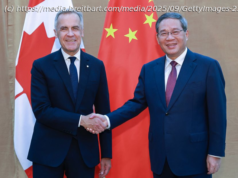It’s not deleveraging. It’s changing who borrows.
Rhetorically, China certainly seems serious about deleveraging. Everyone from President Xi Jinping to the People’s Bank of China to the Public Security Ministry has lately warned about controlling financial risks and promoting stability. Officials are even resorting to exotic zoological analogies — invoking the mythical gray rhino — to describe the looming threats.
In reality, though, there’s been no deleveraging to speak of. New total social financing grew by 14.5 percent in the first half of 2017, up from 10.8 percent in the same period last year and rising roughly 3 percent faster than nominal gross domestic product. It’s true that measures such as credit intensity and the stock of total social financing to GDP have flattened or declined somewhat. But this was due to a temporary surge in commodity prices, now receding quickly. China isn’t so much deleveraging as changing who borrows. Loans to non-financial corporations, for instance, have in fact been scaled back: They’re up a relatively modest 8 percent. But total loans to households are up 24 percent. “Portfolio investment” — code for bank holdings of wealth-management products — is up 18 percent. Combined, household debt and portfolio investment are now 13 percent larger than non-financial corporate debt, and growing by 20 percent on an annual basis. These aren’t small numbers.
Just as worrisome is where this debt is flowing. Wealth-management firms are routinely encouraged to push up commodity prices to drive growth. Total capital inflows from WMPs into commodities rose by 772 percent between January 2015 and June of this year. By tonnage, iron-ore futures trading on July 31 exceeded China’s entire iron-ore output for all of 2016. Given this flood of capital, it’s not surprising that iron-ore future prices are up 87 percent since December 2015. The government is trying to solve its overcapacity problem by having investors and banks prop up prices — even if output and consumption are stable or declining. Relying on triple-digit gains in commodities isn’t a good way to promote stability or sustainable growth.
Another concern is that the mythically prudent Chinese household is no longer quite so prudent. Total household debt now exceeds 100 percent of income. Most of this debt is flowing into real estate. Although gains in so-called tier-one cities have subsided — from year-over-year increases of 30 percent in late 2016 to 10 percent now — prices in tier-three cities are stirring, up more than 8 percent from a year ago and still rising.
In other words, China is spreading the debt burden from corporations to households. Although this might forestall a domino effect should one of China’s big companies start teetering, it’s far from a long-term solution.
Meanwhile, risk continues to build. Corporate deals — such as Dalian Wanda Group Co.’s hastily arranged asset sale to Sunac China Holdings Ltd. — are still going through on worrisome terms. Wealth-management products are increasingly risky as they substitute for bank loans to borrowers locked of the traditional market. Rising household debt carries problems all its own.
Everyone seems aware of these dangers. The PBOC has lately been warning about real-estate bubbles and credit problems, while the International Monetary Fund has sounded the alarm about systemic risks. Startlingly prescient posts have surfaced on Chinese social media, warning of problems at numerous companies well in advance of official crackdowns.
Even so, action is needed more than words. True deleveraging will require some painful steps, such as denying businesses new funding, letting more companies fail and accepting the potential increases in unemployment that result. That won’t be fun for anyone, but it will signal — as nothing else has — that China is finally serious about these problems.
This column does not necessarily reflect the opinion of the editorial board or Bloomberg LP and its owners.
To contact the author of this story: Christopher Balding at cbalding@phbs.pku.edu.cn
To contact the editor responsible for this story: Timothy Lavin at tlavin1@bloomberg.net






